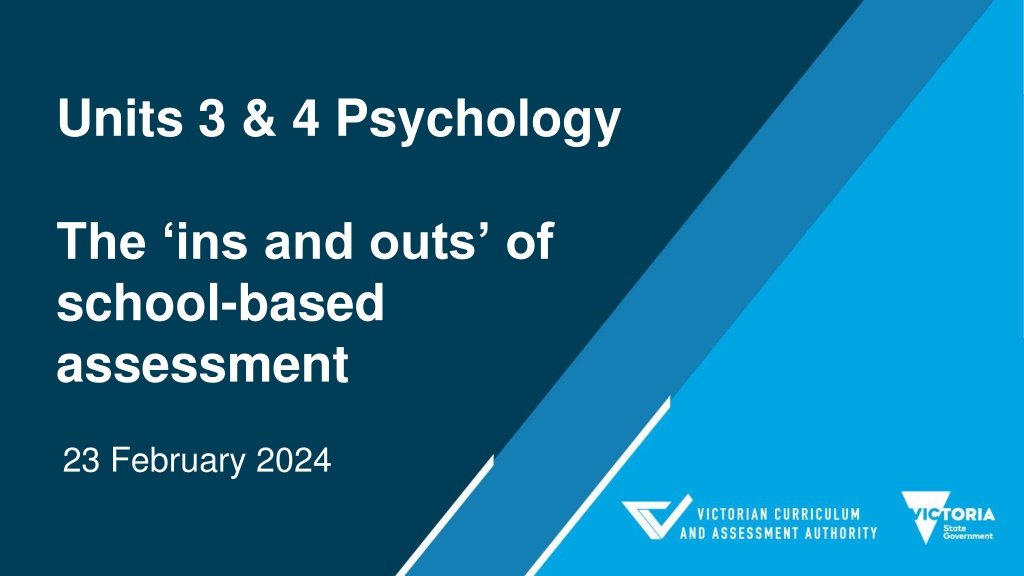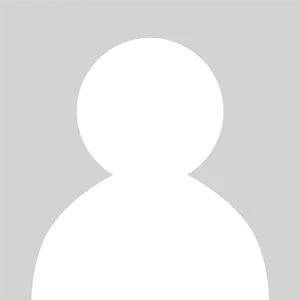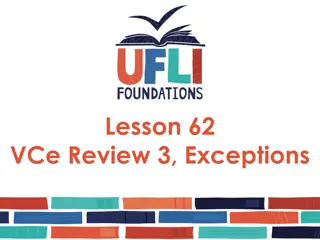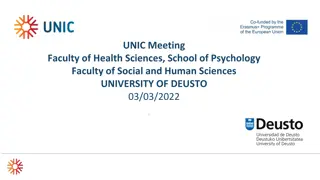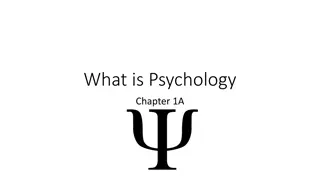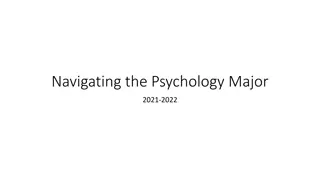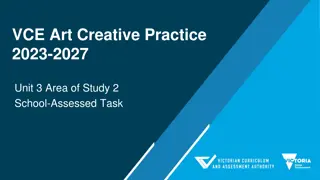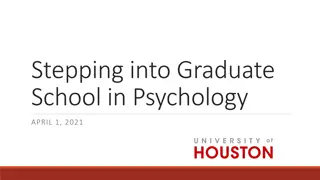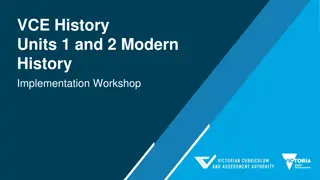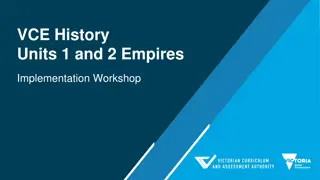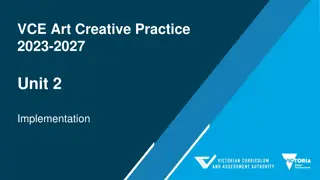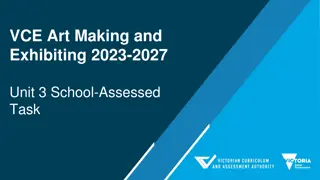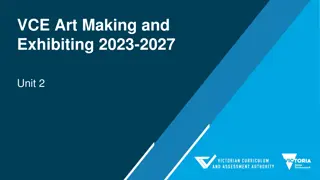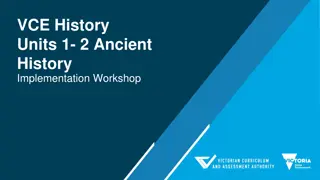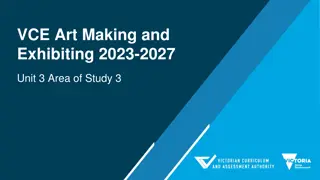The Ins and Outs of School-Based Assessment in VCE Psychology
Assessment in VCE Psychology is essential for demonstrating satisfactory understanding of outcomes through tasks like School-Assessed Coursework (SACs) and exams. Teachers and schools must align tasks with the study design, VCAA principles, and ensure they are tailored to student needs. Satisfactory completion of outcomes is distinct from SAC assessment, with tasks covering various science skills and cognitive levels. Encouraging innovation, sharing ideas, and strategies can enhance assessment quality for Units 3 and 4.
Download Presentation

Please find below an Image/Link to download the presentation.
The content on the website is provided AS IS for your information and personal use only. It may not be sold, licensed, or shared on other websites without obtaining consent from the author. Download presentation by click this link. If you encounter any issues during the download, it is possible that the publisher has removed the file from their server.
E N D
Presentation Transcript
Units 3 & 4 Psychology The ins and outs of school-based assessment 23 February 2024
Acknowledgment of Country I would like to acknowledge the traditional custodians of the many lands across Victoria on which each of you are living, learning and working. For myself, I acknowledge the Dja Dja Wurrung as the traditional custodians of the land from which I am presenting today. I would like to pay my respects to Elders past, present and emerging, for they hold the memories, traditions, culture and hopes of all Aboriginal and Torres Strait Islander peoples across the nation.
Session aims What Do I Need to Do? Build an understanding of assessment requirements in line with the VCE Psychology Study Design and the VCE Assessment Principles What Should I Change for 2024? Build skills and knowledge to increase teacher capacity to develop School- Assessed Coursework (SAC) tasks that are compliant, engaging, rigorous and accessible What Can I Innovate? Encourage innovation by sharing ideas and strategies for each task type at Units 3 and 4
Assessment is a core component of VCE VCE assessment incorporates tasks to show satisfactory understanding of an outcome, school-assessed coursework (SACs) and the exam. Teachers and schools are responsible for designing, delivering and assessing tasks to show satisfactory understanding of an outcome and SACs. These should: Fit the requirements of the current study design and VCAA assessment principles Be unique to the school and designed to fit the needs of the student cohort Integrate key science skills and key knowledge Draw on contemporary science contexts and expose students to novel and real- life contexts
Satisfactory completion of an outcome Satisfactory completion of an outcome is distinct from the assessment of levels of achievement through School-assessed Coursework (SAC) tasks At the Tasks could include class work, logbook activities, textbook activities, worksheets, tests, oral presentations or structured discussions beginning of each outcome students should be informed of the tasks required to satisfactorily complete the outcome Tasks should incorporate a range of key science skills and cater for different cognitive levels Students can redeem a result of an outcome from an N to an S up until the day results are due in VASS
School-assessedCoursework School-assessed coursework tasks (SACs) are graded and used to differentiate student performance Allow consistent judgement for all students of the subject within the school Completed mainly in class within the nominated timeframe Allow for authentication of student work Elicit a spread of results
What Do I Need to Do? Study Design requirements for Units 3 & 4 Each task selected only once across Units 3 & 4 a. Analysis and evaluation of at least one psychological case study, experiment, model or simulation b. Analysis and evaluation of generated primary and/or collated secondary data c. Comparison and evaluation of psychological concepts, methodologies and methods, and findings from three student practical investigations d. Analysis and comparison of two or more contemporary media texts and student-designed investigation related to content in Units 3 and/or 4 Time allocation of 50-70 minutes for a written response and 10 minutes for a multimodal or oral presentation
What Do I Need to Do? Study Design requirements for Units 3 & 4 Each task must incorporate a representative sample of key knowledge and relevant key science skills Note: Although all elements of each outcome must be met by students in order to be awarded an S , a representative section of the outcome is sufficient as the basis for SAC task development. Key knowledge not covered in the SAC may be assessed through a task to show Satisfactory understanding (eg. logbook tasks, textbook based tasks, classroom activities, test) Note: Helpful to use a copy of the Study Design to map assessment for the Outcome slide 6 Note: Use VCAA checklist to ensure that over the year a broad range of key science skills are assessed slide 7
Example of mapping assessment for an outcome
What Do I Need to Do? Create tasks that elicit a spread of results and allow achievement of the highest level of performance multiple entry points to allow accessibility for all students differentiated item difficulty to extend the top end and engage the low end 25-50-25 rule of thumb for overall item cognitive difficulty * Difficulty is relative for each individual cohort of students
What Do I Need to Do? Identify and follow the task commands Each task type has embedded command terms analysis, evaluation, comparison eg. Analysis and evaluation of generated primary and/or collated secondary data eg. Analysis and comparison of two or more contemporary media texts The task must clearly align with these commands Refer to the VCAA Glossary of Command Terms
What Do I Need to Do? VCE Assessment Principles Valid and Reasonable The task fits the requirements of the Study Design The task covers a representation of key knowledge from the outcome to enable student performance to be differentiated Students have been provided with necessary information both prior to the SAC and on the SAC itself (this includes outcome details, type of task, conditions of task, contribution to final outcome score)
What Do I Need to Do? VCE Assessment Principles Equitable If commercial tasks are being used, they have carefully checked to ensure they meet task requirements AND been significantly modified to ensure that any prior access to the task would not provide an advantage to a student and therefore disadvantage others The task does not privilege or disadvantage certain groups on the basis of gender, culture, physical disability, socioeconomic status or geographical location If students are offered a choice of task, or there are different tasks provided to classes, then these are comparable in scope and demand The task does not allow for drafting or undue teacher assistance
What Do I Need to Do? VCE Assessment Principles Balanced A range of question types with varying cognitive demand to ensure student performance can be differentiated (use Bloom s and consider the 25-50-25 rule) The mark allocations accurately reflect the question difficulty Students have been provided with appropriate information on how the task will be assessed If VCAA performance descriptors are being used then then these have been carefully checked and modified, to ensure that they fit the nature of the task The mark allocation aligns with the Study Design and any rounding does not influence student ranking
What Do I Need to Do? VCE Assessment Principles Efficient The task is not over-assessing students in terms of the number of tasks set or the task being outside the Study Design demands The task does not generate undue stress on students in regards to the timing of the tasks in relation to one another The task can reasonably be completed in the nominated timeframe
What can I innovate? What can I change for 2024? Innovation and change Increases authentication Keeps topics contemporary and relevant Sets students up for the exam exposing to real life and novel contexts Helps ensure each task meets the requirements of the current Study Design and the assessment principles
Analysis and evaluation of at least one psychological case study, experiment, model or simulation Good tasks for Case study et al will Be based on stimulus material/s that provide sufficient information for students to analyse and evaluate Select, modify and release text/s to meet the needs of the cohort Clearly relate all questions to the stimulus material Allow students to demonstrate a variety of key science skills (such as analyse and evaluate data and investigation methods see page 12 & 13 of Study Design)
A good case study stimulus will Be more than a scenario type vignette Be more than a vignette from a clinical practice perspective ie. A summary of a client that a psychologist may write Include information to highlight that a case study is a scientific investigation methodology (like a controlled experiment or correlational study) Include information on the research aim and question under investigation Include information on the methods used to conduct the case study (eg. fieldwork interviews, psychological testing) Include information on the data gathered and the research findings
Case study et al task Possible applications to Unit 3, Outcome 1 (Nervous system) Analyse and evaluate a case study of an acquired spinal cord injury based on nervous system content and the theories of stress Analyse and evaluate an experiment on the effectiveness of fermented food to gut health and mood/ or a study from the Food and Mood Centre at Deakin University Analyse and evaluate a student created model of neural transmission
Case study et al task Possible applications to Unit 3, Outcome 2 (Learning & Memory) Analyse and evaluate case studies of acquired brain damage in terms of the likely effects on memory & learning Analyse and evaluate a class-based experiment on the effectiveness of a mnemonic device and/or an approach to learning, such as classical conditioning Analyse and evaluate a student created model of the brain highlighting the regions involved in memory and their functions
Case study et al task Possible applications to Unit 4, Outcome 1 (Sleep) Analyse and evaluate a case study on sleep deprivation in a particular cohort eg. in a shift worker or a long haul truck driver Analyse and evaluate a case study whereby students design and implement a new sleep hygiene habit over a period of two weeks or more (with themselves or family member as subject) Analyse and evaluate a student created animal model that tests the impact of an eating pattern (eg. larger morning vs evening meal, fasting, carbohydrate ratio) on daily rhythms in melatonin, core body temperature and heart rate Analyse and evaluate an experiment that uses driving simulators to research the impacts of sleep deprivation on driving ability
Case study et al task Possible applications for Unit 4, Outcome 2 (Mental wellbeing) Analyse and evaluate a controlled experiment on the effectiveness of a treatment for specific phobia (could include one or more of CBT, systematic desensitisation, benzodiazepines, psychoeducation) Analyse and evaluate research using virtual reality exposure therapy for specific phobias Analyse and evaluate a program designed to support Aboriginal peoples mental wellbeing by considering the Social and Emotional Wellbeing Model (SEWB) and cultural determinants Analyse and evaluate the Headspace Yarn Safe website in terms of how it reflects aspects within the Social and Emotional Wellbeing model Analyse and evaluate a range of models (such as biopsychosocial model, SEWB model, continuum model) in terms of their usefulness in understanding and maintaining mental wellbeing
Analysis and evaluation of generated primary and/or collated secondary data Good tasks for Primary and/or secondary data will Scaffold the task as appropriate for the cohort Allow students to access and/or present data in a range of formats including tables, graphs and charts Note: Primary data may be from teacher led class-based activities or individual student designed and conducted activities Focus on analysis and evaluation of the data in relation to selected key knowledge (no question fillers unrelated to the stimulus!)
Primary and/or secondary data Possible applications to Unit 3, Outcome 1 (Nervous system) Analyse and evaluate primary data generated through a class activity on speed of neural transmission between different body parts Analyse and evaluate primary data generated through a fieldwork survey on sources of stress and coping mechanisms in family members Analyse and evaluate secondary data on stress in the Australian population (eg. APS survey findings) Analyse and evaluate secondary data from a range of studies on yoga and GABA levels
Primary and/or secondary data Possible applications to Unit 3, Outcome 2 (Learning & Memory) Analyse and evaluate primary data generated through class-based controlled experiments to compare the effectiveness of two different mnemonic devices Analyse and evaluate primary data gathered through a class-based controlled experiment on classical conditioning (such as pairing of a specific word and water gun) Analyse and evaluate secondary data on the use of operant conditioning to train animals Analyse and evaluate secondary data on classical conditioning and pain perception
Primary and/or secondary data Possible applications to Unit 4, Outcome 1 (Sleep) Analyse and evaluate primary data gathered through a range of activities such as: o Fieldwork- Sleep log o Product development data from phone app or wearable device o Correlational study on sleep quality/quantity and another factor (such as mobile phone use) o Correlational study on amount of sleep and reaction time o Fieldwork on sleep patterns across the lifespan Analyse and evaluate secondary data on the effectiveness of different sleep intervention/s for healthy sleep behaviour (this could be sleep hygiene practices, bright light therapy, drinking patterns) Analyse and evaluate a range of secondary data sources related to shift work in a particular cohort (such as health care workers). Include data to consider the impact of shift work on psychological and physiological functioning and the effectiveness of different interventions
Primary and/or secondary data Possible applications for Unit 4, Outcome 2 (Mental wellbeing) Analyse and evaluate primary data gathered through a controlled experiment on the impact of mindfulness meditation on psychological and physiological functioning Analyse and evaluate primary data gathered through a correlational study exploring the relationship between sleep and levels of resilience Analyse and evaluate secondary data gathered through use of a product designed to improve mental wellbeing, such as a phone app. Analyse and evaluate multiple secondary data sources for specific phobia interventions within the biopsychosocial framework, including: o Biological effectiveness of GABA agonists and/or breathing retraining o Psychological CBT and/or systematic desensitisation o Social - psychoeducation
Comparison and evaluation of psychological concepts, methodologies and methods, and findings from three student practical investigations Good tasks for practical activities will Have a carefully selected range of activities to ensure comparison (similarities and differences) between methodologies and methods Note: you are encouraged to use different methodologies Focus the questions/tasks on comparison and evaluation (rather than separate short answer questions for each activity) Allow students to make connections and links between the three practicals Consider how to use the logbook to record findings, whilst also ensuring authentication is maintained
Practical activities task Possible applications to Unit 3, Outcome 1 (Nervous system) Analyse and evaluate nervous system functioning using three activities such as: o Controlled experiment - Visual vs auditory reaction times o Simulation - Walk the plank virtual reality activity to measure activation of heart rate o Modelling Create a 3D model to compare inhibitory vs excitatory neurotransmission and/or compare the process of neurotransmission and neuromodulation Analyse and evaluate stress responses using three activities such as: o Correlational study Stress levels and another factor (such as intake of fermented foods) o Fieldwork Survey to assess levels of coping flexibility (could be based on existing questionnaires) o Fieldwork/case study Interview a student/guardian on the effectiveness of approach vs avoidance coping strategies in their own real-life studies and/or work
Practical activities task Possible applications to Unit 3, Outcome 2 (Learning & Memory) Analyse and evaluate the Atkinson-Shiffrin multi-store model of memory with three controlled experiment activities such as: o Sensory memory iconic memory test (web search for free available demos/tests) o Short term memory tests for both capacity and duration (Neuroscience for Kids website has some great resources) o Long term memory effectiveness of a specific mnemonic technique
Practical activities task Possible applications to Unit 4, Outcome 1 (Sleep) Analyse and evaluate the demand for sleep and the effects of sleep disruption with three activities such as: o Fieldwork - Sleep log o Fieldwork - Sleep patterns across the lifespan o Correlational study- Amount of sleep & performance on a cognitive test (eg. short term memory) o Modelling - Design an animal model study to test the impact of an eating pattern (eg. larger morning vs evening meal) on daily rhythms in melatonin o Fieldwork/case study interview a person who regularly performs shift work to understand impacts on sleep patterns and physiological and psychological functioning
Practical activities task Possible applications to Unit 4, Outcome 2 (Mental Wellbeing) Analyse and evaluate the biopsychosocial model using three practical activities as reference: o Biological - student created 3D model to highlight role of GABA and GABA agonists in specific phobias o Psychological - role play of systematic desensitisation o Social - analyse online psychoeducation resource Analyse and evaluate the effectiveness of mindfulness meditation using three practical activities such as: o Controlled experiment impact of mindfulness meditation on an objective physical measurement (such as heart rate) and a subjective psychological measurement (such as level of stress) o Correlational study use of mindfulness meditation and stress levels o Fieldwork/case study interview with a person who regularly uses mindfulness meditation to understand short and long term benefits of practice
Analysis and comparison of two or more contemporary media texts Good tasks for media texts will Be based on texts that allow for analysis and comparison Consider using texts written for different audiences with varying scientific merit Consider using texts that explore different psychological theories/models/ideas Consider using texts that highlight different methodologies and methods Be based on contemporary and interesting texts to suit cohort Include a range of questions to compare and critically analyse the texts to construct evidence-based arguments and draw conclusions Assess a representative sample of key knowledge and relevant key science skills
Media texts task Possible applications to Unit 3, Outcome 1 (Nervous system) Analyse and compare different texts focussed on technique/s for coping with stress. This could include: ~ a less scientific text type (eg. TikTok clip on vagus nerve exercise, Instagram post on gut health) ~ a more scientific text type (such as a journal article) summarising a controlled experiment on the same stress reduction strategy or a different model/theory. Analyse and compare texts that focus on different models of stress in the context of sport (eg. General Adaptation Syndrome and Transactional Model)
Media texts task Possible applications to Unit 3, Outcome 2 (Learning & Memory) Analyse and compare texts highlighting different theories of learning, such as: o Parenting advice using operant conditioning to manage difficult behaviour in toddlers/teenagers o Journal article summary related to classical conditioning and cancer treatment o YouTube clip on how to change a car tyre Analyse and compare texts related to improving memory for study, such as: o Social media clips o Newspaper article o Journal article summary on effectiveness of a specific mnemonic for study
Media texts task Possible applications to Unit 4, Outcome 1 (Sleep) Analyse and compare a social media post, newspaper article and an experiment abstract on the topic of sleep hygiene Analyse and compare texts aimed at improving sleep in shift workers. This may include a pdf from an organisation such as SafeWork Australia, posts from a website such as The Other Shift Blog, online video with tips for nightshift workers Analyse and compare promotional material for blue-light glasses (or similar product) with controlled experiment findings on their effectiveness
Media texts task Possible applications to Unit 4, Outcome 2 (Mental Wellbeing) Analyse and compare a range of texts highlighting different interventions for specific phobia (within the biopsychosocial model) Analyse and compare a series of Australian webpages promoting mental wellbeing, in regards to coverage of the biopsychosocial model and Social and Emotional Wellbeing model
Good tasks for the student designed investigation will Provide clear instruction and scaffolding based on needs of student cohort Have clear processes in place to ensure authentication Ensure student questions have some scientific basis Include a process for ethical considerations to be considered meaningfully by the student and signed off by the teacher Encourage students to carefully consider the design of the investigation and ways to minimise errors Assign the logbook a significant part of the final mark
Good scientific posters will Follow the VCAA template and stick to the word limit Use a question as the title Include data in the most appropriate format (such as a graph) with appropriate scaling, axes and labelling Use an easy to read font size and font Use graphics/illustrations/flowcharts to balance words Use the logbook to provide more detailed information and copies of relevant materials Further advice about the construction of scientific posters can be found under Scientific Posters in the Planning section of the Psychology Support Materials.
Student designed investigation Consider allowing students to use any of the methodologies not just a controlled experiment Increase student choice and engagement Increase student understanding of methodologies Better assess student ability to select and use appropriate methods Cater for different learning styles and needs (and access to participants) Consider how to support and scaffold learning depending on methodology chosen? Options - Introduce at year 11 if possible, break out groups in class, handouts, direct to online resources
Student designed investigation Ideas Correlational study related to stress or sleep and another factor Fieldwork surveys on stress coping strategies/impacts of shift work or ASPD Case study on effectiveness of a memory strategy/approach to learning/mindfulness meditation over time Case study impacts of aphantasia on a range of specific memory tasks Process development design and evaluate new process to improve sleep or reduce stress
Good assessment will Be created in collaboration Incorporate internal or external cross-marking and/or moderation Use the VCAA performance descriptors as a guide (particularly to consider most relevant key science skills) Tailor the assessment criteria/descriptors/rubrics/marking schemes to the task Note: If the VCAA performance descriptors are used then these should be modified to fit the actual task carried out If using a marking scheme ensure it is detailed and includes a clear breakdown of mark allocation
VCE resources VCAA Psychology webpage VCE Administrative Handbook 2024 VCE Psychology Study Design 2023-2037 VCAA VCE webpage
Contact Erin Wilson Curriculum Manager, STEM ? ? ? 03 9059 5157 erin.wilson@education.vic.gov.au www.vcaa.vic.edu.au vcaa.vce.curriculum@education.vic.gov.au
